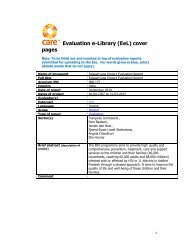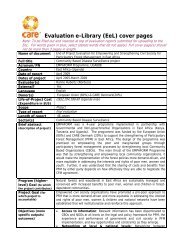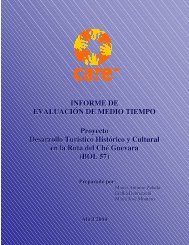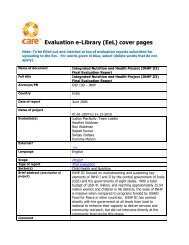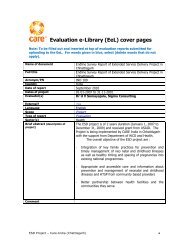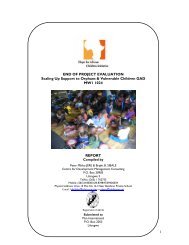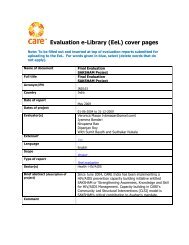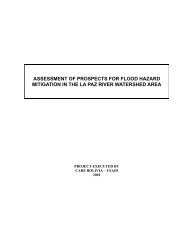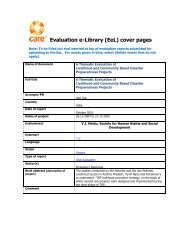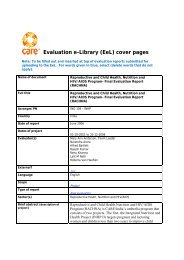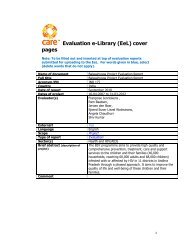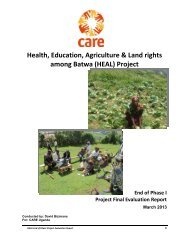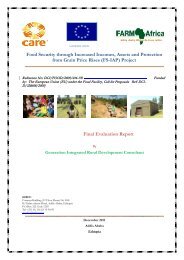IND 199 ECDE Baseline - CARE International's Electronic ...
IND 199 ECDE Baseline - CARE International's Electronic ...
IND 199 ECDE Baseline - CARE International's Electronic ...
- No tags were found...
You also want an ePaper? Increase the reach of your titles
YUMPU automatically turns print PDFs into web optimized ePapers that Google loves.
xc91 CHAPTER- IX92 OBSERVATIONS ON THE PRE-SCHOOL EDUCATION PROGRAMME AT THE SERVICESOF ANGANWADI CENTRESThis study collected data on anganwadi centres and their functioning in two ways. In thefirst approach, the AWWs were interviewed to collect information on their knowledge of theactivities she performs and on functioning of the AWCs; focus was on the information relatedto her activities (programme contents) related to the growth and development of children.The second approach was to observe AWCs, for their physical infrastructure and contents ofthe services for children ages 0-3 years and the contents of the pre-school education. Whilethe information based on the interview of the AWWs has been discussed in chapter VIII, thischapter discusses the findings of the observations on the AWCs.The checklist developed for the pre-school education programme has observations recordedin three major components:• Existence of infrastructure in the AWCs, and• Coverage of the pre-school programme content, which was further divided into six subsections(i) learning /play aids, programme schedule and class arrangements, (ii)personal care, hygiene and habit formation, (iii) language and reasoning experience, (iv)creative activities, (v) social development,• Services to children 0 – 3 yearsWhile making observations on three components of services at AWCs, the checklist hadcategorized these components in different sub-components within a broad category of acomponent. For instance, component of pre-school education was further divided into fivesub-components (learning, personal care and hygiene, language and reasoning experience,creative activities and Social development activities). Each of these sub-component wasfurther sub-divided into a few activities related to development of the sub-component. Whilemaking observation, the field investigator had to categorize the level of the activity into poorsituation, intermediate situation and the best situation (all relative terms and have beendefined in the checklist). This type of categorization had advantage that these levels could bescored from 0 to 2—score zero for the poorest situation and score two for the best situation.Therefore, we have two indicators for each activity—percent distribution of the AWCsinto three levels and mean score of the activity, computed on the basis of scoring levelsof 0,1 or 2.Next sections of this chapter will study each of these component/sub-component and theactivity, one by one.93 9.1 Physical infrastructure at the AWCsSeven sub-components of the infrastructure were observed for the study. They were (1)toilet availability and use, (2) availability of water in toilets, (3) hazards around the centre(AWC) or pre-school classes, (4) clean/unclean surroundings near the AWC and pre-schoolclasses, (5) safety level of the building, (6) noise pollution, and (7) sitting facility for children.Table 9.1 shows percentage distribution of the AWCs and the mean score for each of theseseven sub-components.<strong>Baseline</strong> Study Of Early Childhood Care And Development Project In ChattisgarhApril,2012



